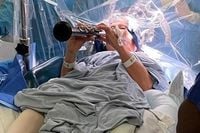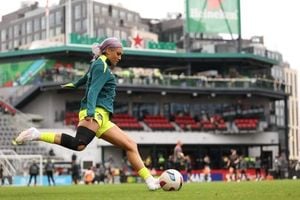On October 22, 2025, the operating theatre at King’s College Hospital in London buzzed with an energy that was equal parts anticipation and hope. Denise Bacon, a 65-year-old retired speech and language therapist from Crowborough, Sussex, lay awake on the table, her head cradled in a precise surgical frame. But instead of the usual hush that accompanies brain surgery, the room filled with the warm, familiar notes of a clarinet. In a remarkable display of medical innovation and personal courage, Denise played her instrument while surgeons worked deep within her brain, aiming to restore movement lost to Parkinson’s disease.
Denise’s journey began more than a decade ago, when she was diagnosed with Parkinson’s in 2014. The disease crept into her life gradually, bringing with it slowness of movement and muscle stiffness that eroded her ability to walk, swim, dance, and, perhaps most heartbreakingly, play the clarinet with the East Grinstead Concert Band. Five years ago, her symptoms forced her to set her beloved instrument aside. “I’m already experiencing improvements in my ability to walk, and I’m keen to get back in the swimming pool, and on the dance floor to see if my abilities have improved there,” Denise shared after her surgery, her optimism shining through, according to Sussex Express.
Parkinson’s disease is a progressive neurological disorder affecting more than 10 million people worldwide, as noted by the Parkinson’s Foundation and reported by NewsNation. Its symptoms—muscle rigidity, tremors, and slowed movement—can make even simple daily activities a struggle. For Denise, these challenges were deeply personal, robbing her not only of mobility but also of cherished hobbies and social connections. Yet, it was precisely this passion for music that would become central to her treatment.
The procedure Denise underwent is called Deep Brain Stimulation (DBS), a technique reserved for patients with movement disorders that do not respond well to medication. Led by Professor Keyoumars Ashkan, MBE, a renowned neurosurgeon at King’s College Hospital, the four-hour operation involved implanting electrodes into specific regions of Denise’s brain. These electrodes were connected to a rechargeable pulse generator battery, similar in size and function to a pacemaker, which was implanted in her chest. The battery is designed to last up to 20 years before needing replacement and delivers a continuous stream of electrical impulses to help modulate brain activity and, crucially, reduce the symptoms of Parkinson’s.
“Deep Brain Stimulation, where stimulating electrodes are placed into the deep structures of the brain, is a long-established procedure to improve motor symptoms in patients with movement disorders,” Professor Ashkan explained in a statement published by Sussex Express. “Holes half the size of a five pence piece were made in Denise’s skull after a frame with precise coordinates was placed on Denise’s head, acting as a sat nav to guide us to the correct positions within the brain to implant the electrode.”
The operation was a team effort, supported by a neurologist, a neuropsychologist, and a cadre of DBS and theatre nurses. Before the team began their delicate work, Denise received a local anesthetic to numb her scalp and skull. The brain itself, curiously, feels no pain, so she could remain awake and alert throughout the procedure. This was no ordinary choice—it was essential. By keeping Denise conscious and inviting her to play the clarinet, the surgical team could monitor her motor skills in real time, adjusting their approach and the level of stimulation to maximize benefit and minimize risk.
As the electrodes were implanted and the current switched on, the effects were immediate—and visible. Professor Ashkan recounted, “Once the electrodes were in place on the left side of Denise’s brain, the current was switched on and an immediate improvement was noted in hand movements on her right side. The same happened on her left side when we implanted electrodes on the right side of her brain.” The hospital described the results as “instantaneous.” Denise’s ability to move her fingers improved, allowing her to play her clarinet with a fluidity she hadn’t experienced in years.
Denise herself was overjoyed with the outcome. “I remember my right hand being able to move with much more ease once the stimulation was applied, and this in turn improved my ability to play the clarinet, which I was delighted with,” she said, as quoted by both NewsNation and Sussex Express. The transformation was not limited to her musical performance. Denise also reported a newfound ease in walking and an eagerness to return to swimming and dancing—activities she’d missed dearly.
The decision to have Denise play the clarinet during surgery was more than a symbolic gesture; it was a practical measure. As King’s College Hospital explained, the real-time feedback provided by her playing allowed surgeons to see and hear the immediate impact of their work. This direct observation enabled them to fine-tune the placement and stimulation of the electrodes, ensuring the best possible outcome for Denise’s unique needs and aspirations. “As a keen clarinettist, it was suggested Denise bring her clarinet into the operating theatre to see whether the procedure would improve her ability to play, which was one of Denise’s main goals for the surgery. We were delighted to see an instant improvement in her hand movements, and therefore her ability to play, once stimulation was delivered to the brain,” Professor Ashkan added.
The technology behind Denise’s recovery is impressive in its own right. The rechargeable pulse generator not only delivers continuous electrical currents but also monitors brain activity, allowing for automatic adjustments to the stimulation as needed. This means that Denise can expect a consistent level of symptom relief for up to two decades without the need for frequent surgical interventions.
Stories like Denise Bacon’s highlight the intersection of medical science and the human spirit. They remind us that behind every procedure and every innovation, there’s a person with passions, dreams, and a life waiting to be reclaimed. For Denise, the clarinet is more than an instrument; it’s a symbol of resilience and hope—a melody that, for a moment, turned an operating theatre into a concert hall.
As medical teams continue to refine and personalize treatments for Parkinson’s and other neurological disorders, Denise’s experience stands as a testament to what’s possible when technology, expertise, and patient-centered care come together. For now, she looks forward to making music, moving with freedom, and savoring the simple joys of life—one note, one step, one dance at a time.




